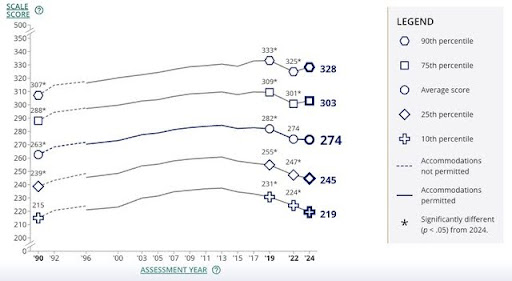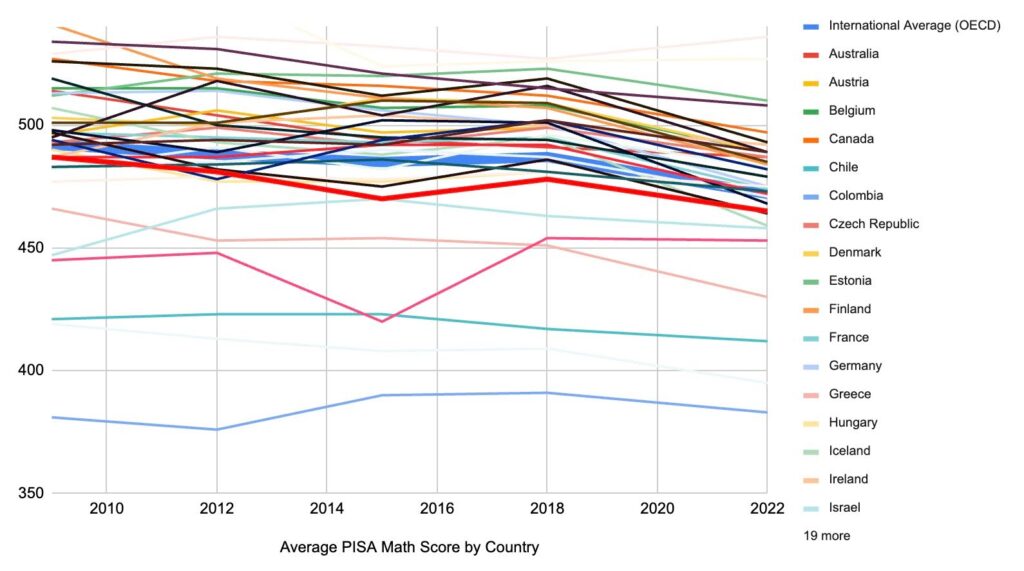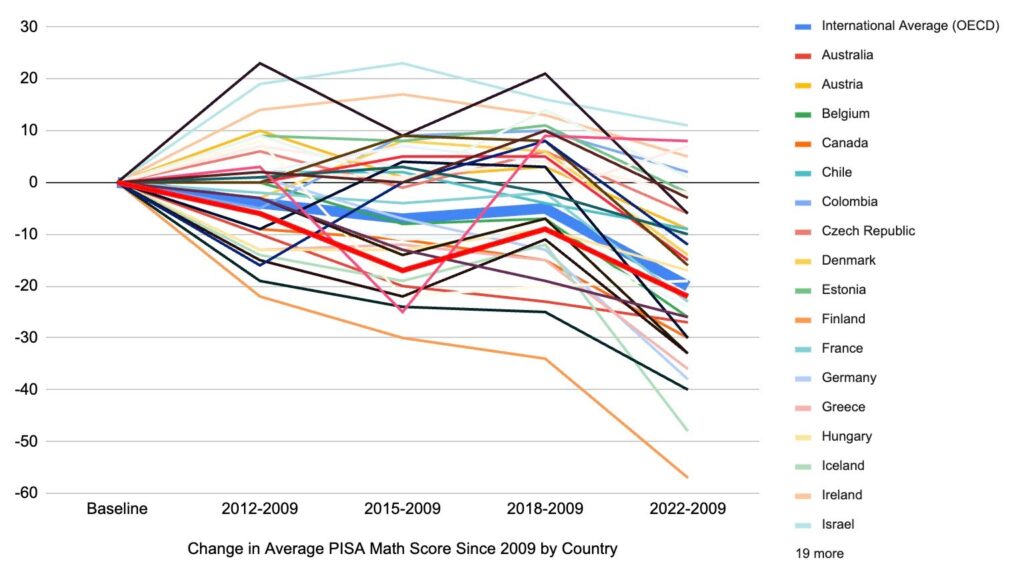By Dave Kung

The kids are not alright – at least not in terms of their mathematical preparation for college. That’s one thing nearly everyone agrees on in the wake of a recent UCSD report about their incoming freshmen. The Senate-Administration Workgroup on Admissions (SAWG) report paints a shocking enough picture of students’ math skills to generate stories in outlets from the Wall Street Journal to The Atlantic.
Most math instructors I’ve talked with agree that there is a problem. Many more students than in the past are arriving to college not understanding middle and elementary school mathematics enough to be placed into the college-level courses needed for their intended programs.
Most also agree that the pandemic was bad for student learning, but the agreement stops there. Like a Rorschach test, people see what they want in the data, whether from their own campus or at UCSD. They point to their own pet peeves–whether it’s test optional admissions, high school grade inflation, an under-qualified teaching force, the impact of smartphones, the introduction of the Common Core, the end of school-level accountability measures, or widely varying school quality.
(Which one of these purported causes do you think is most likely to blame? Read on for my best guess.)
It’s worth taking a careful look at what the UCSD report says – and what it doesn’t. The eye-popping statistic is that the number of students being placed into the most basic math course (Math 2) has exploded from just 32 students in 2020 to 665 this year, with an additional 256 students in a new, slightly less remedial course. While that growth is certainly alarming, those students collectively represent just 12% of the incoming class. The kids at the other end of the table appear to be just fine. The percentage of students placing into STEM calculus has stayed in the 60% range (going from 65.6% to 61.5%).
This phenomenon where overall average math competencies are going down, but the drops are worse for those scoring at the bottom, matches what I hear from math faculty across the country. It also mirrors the data we see from NAEP, the nation’s report card. After rising for decades, NAEP scores peaked somewhere around 2012, heading downward ever since. However, the dip didn’t happen across all students. The top scoring 4th graders are doing better than ever; the top 8th graders have almost regained pandemic losses. Gaps below that have widened significantly. The lowest scoring tenth of students have fallen back to where they were 25 years ago.


Importantly, the downward trend since around 2013 matches what has happened around the (developed) world. The PISA test is taken by random samples of 15 year-old students in dozens of countries. Pulling data from their website, the downward trend is easy to see visually (adjusting the range to highlight changes on the order of 20-40 points on overall scores around 500.)

Graphing changes in scores since 2009 makes this trend even clearer. The pandemic accelerated a downward trend that started a decade before. The 22-point drop in the US (in red) has tracked fairly closely to the OECD average (down 20 points). (Dive into the data yourself if you’d like to.)

And the problems don’t even stop with kids. Adult literacy and numeracy skills are going down. Literacy rates in Europe are falling - and as with NAEP scores, gaps are growing. There are enough attention issues at all levels that there’s an entire best-selling book about the problem.
The fact that scores are falling not just at UCSD, not just in the US, not even just for students suggests that something bigger is going on. Most of the explanations for the troubles seen at UCSD ignore these larger global trends. And while I’m reminded of my mentor Uri Treisman’s observation that multi-dimensional problems rarely have one dimensional causes (or solutions), it does seem to me that one explanation needs further examination – one that would explain both the local and global phenomena.
Starting between 2010 and 2015, access to smart phones spiked for high school-aged teens in the US. By 2015, 73% of 13-17 year olds had access to a smartphone. That has now risen to 95%.
Heavy smart phone usage correlates with worse grades (with larger effects for elementary and middle-school students), worse recall, worse mental health, and less self-regulated learning. Smart phones reduce our cognitive capacity – even if they are off but within reach.
So phones are a plausible explanation for the dip in scores across the world. How exactly do phones explain the widening gaps we see? As a math teacher coach, I regularly visited classes in a local high school before and after a cell phone ban. The difference was drastic – but more so in the lower level classes. Before the ban, AP Calc and AP Stats students largely didn’t have their phones. In less academically rigorous classrooms the change was far more profound. I saw for myself how phones differentially distracted students who were less bought into the academic enterprise.
To be clear, I’m not arguing that students’ access to phones in class is the entire problem. Banning phones at school does appear to help, but the impact is not nearly enough to explain the drops. Instead, I’m talking about the decision we have collectively made (across all developed nations) to get kids hooked on something as addictive as cocaine, put an infinite supply in their pockets, ask them to be responsible about using it (“Wait until lunch, please!”), and then point fingers elsewhere when their learning suffers.
Maybe I’m wrong. There are other potential explanations for the global downturn in scores. Maybe everyone is impacted by worries about climate change, economic uncertainty, and the turn toward authoritarianism – and smart phones just give us easier access to upsetting information. But chances are that you’ve paused your reading of this essay to glance at something else on your phone. They are that addictive and that distracting. Smart phones seem like the most likely culprit to me.
A decade ago when everyone was aghast at racial gaps in standardized test scores, we made the mistake of changing the thing that was within our control (admissions requirements) instead of working to fix the harder underlying causes: wealth inequality, segregation, and lack of opportunity. Let’s not make the same mistake again. This time, let’s not only work on what’s within our control – smoothing out the transition from high school to higher education in terms of content, expectations, and pedagogy. Let’s simultaneously work to limit the disastrous effect smart phones are having on our children. What would that look like? I don’t have a clear picture – but I’m eager to hear your ideas.
What do you suggest we do? Come join the conversation on MAA Connect.

Dr. Dave Kung has worked in the intersection of mathematics and equity for three decades. He served as the Director of Policy at the Charles A. Dana Center at The University of Texas at Austin, and as Director of MAA Project NExT. He also works closely with K-12 and higher ed organizations, especially concentrating on equity issues in mathematics. Kung was awarded the Deborah and Franklin Tepper Haimo Award, the MAA’s highest award in college math teaching, for his work at St. Mary’s College of Maryland. He resides there, serving as Executive Director of Transforming Post-Secondary Education in Mathematics (TPSE Math) and working as an independent consultant, as well as playing violin and running–never simultaneously, but sometimes alongside his partner and daughter. The views expressed in this column are Dave’s alone and do not represent those of any organizations he works with or for.
You can follow Dr. Kung on:
